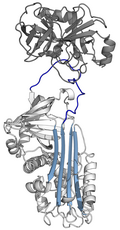Wikipedia:Today's featured article/requests/Serpin
Serpin
[edit]- This is the archived discussion of the TFAR nomination for the article below. Subsequent comments should be made on the appropriate discussion page (such as Wikipedia talk:Today's featured article/requests). Please do not modify this page.
The result was: scheduled for Wikipedia:Today's featured article/April 2, 2016 by — Chris Woodrich (talk) 00:37, 18 March 2016 (UTC)
Serpins are a superfamily of proteins with similar structures that were first identified for their protease inhibition activity and are found in all kingdoms of life. They are notable for their unusual mechanism of action, in which they irreversibly inhibit their target protease by undergoing a large conformational change to disrupt its active site. This contrasts with the more common competitive mechanism for protease inhibitors that bind to and block access to the protease active site. Protease inhibition by serpins controls an array of biological processes, including coagulation and inflammation, and consequently these proteins are the target of medical research. Their conformational-change mechanism confers certain advantages, but it also has drawbacks: serpins are vulnerable to mutations that can result in serpinopathies such as protein misfolding and the formation of inactive long-chain polymers. Serpin polymerisation not only reduces the amount of active inhibitor, but also leads to accumulation of the polymers, causing cell death and organ failure. (Full article...)
- Most recent similar article(s): Amphetamine (2015-05-03) and Major urinary proteins (2010-01-25)
- Main editors: Evolution and evolvability, delldot, Jfdwolff, Aa77zz, Seppi333, Opabinia regalis, Jcwhizz, Ian Rose.
- Promoted: March 11, 2016
- Reasons for nomination: It has been a while since a biochemistry/medical page has been featured and I think some of the features and diagrams are quite striking, as well as having both medical and biological relevance. It would be my first FA to appear at TFA.
- Support as nominator. T.Shafee(Evo﹠Evo)talk 00:24, 13 March 2016 (UTC)
- Support. Interesting subject from a medical and scientific standpoint. DOI created article. JFW | T@lk 00:43, 13 March 2016 (UTC)
- Support - we don't get many articles like this on the main page. Seppi333 (Insert 2¢) 01:12, 13 March 2016 (UTC)
- Support and congratulations! This is an excellent opportunity to show some cool science on the main page. (I think you must have used the "main editors" section to list the FA reviewers? Because I certainly don't qualify! But thanks for the ping ;) Opabinia regalis (talk) 04:42, 13 March 2016 (UTC)
- Support yes, more STEM articles plz. Cas Liber (talk · contribs) 12:27, 13 March 2016 (UTC)

